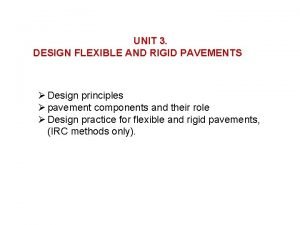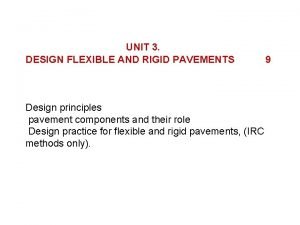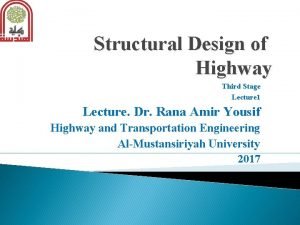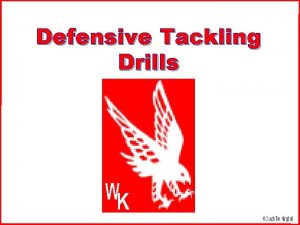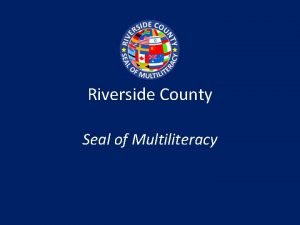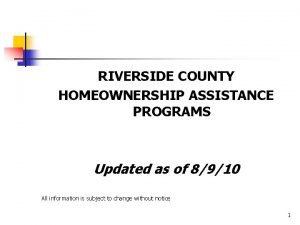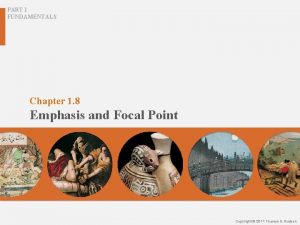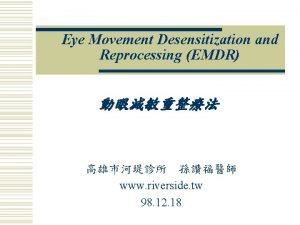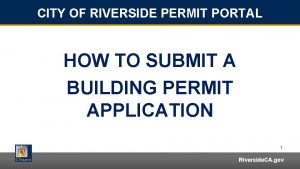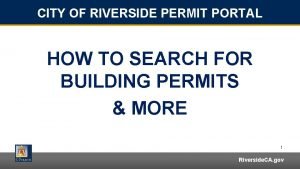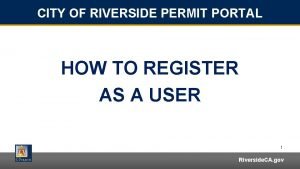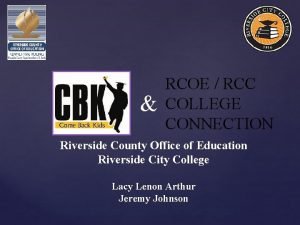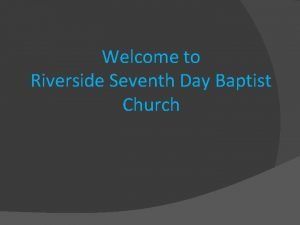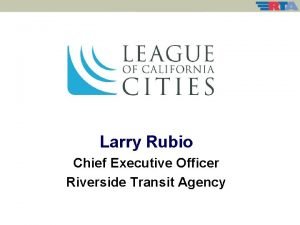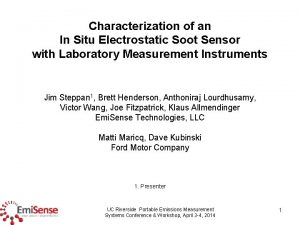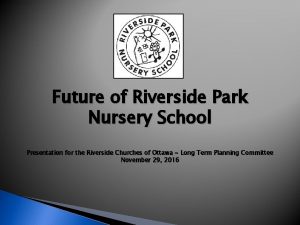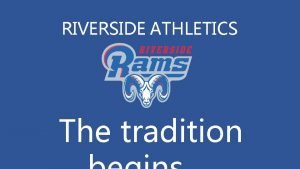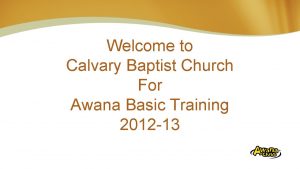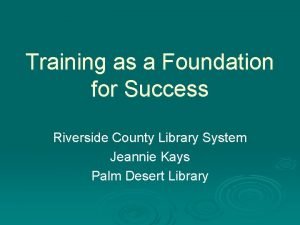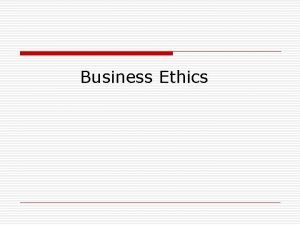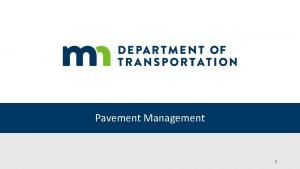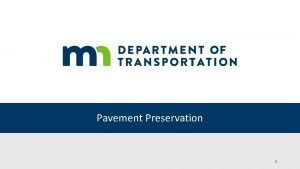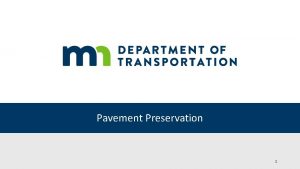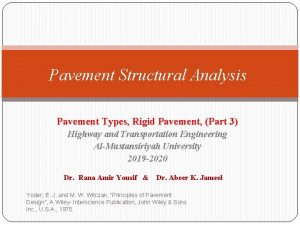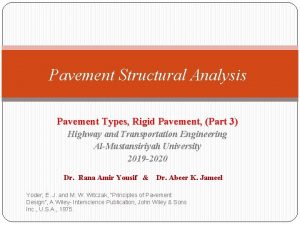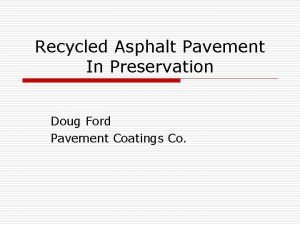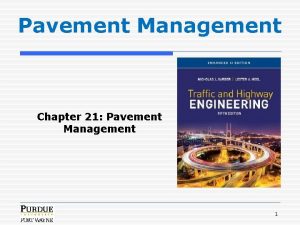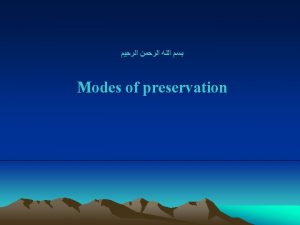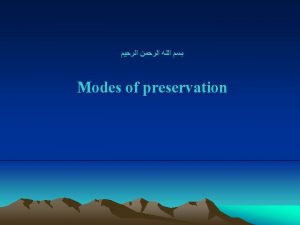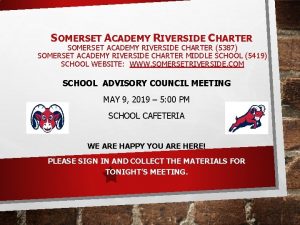Pavement Preservation Philosophy utilizing Pavement Management Systems Riverside




























- Slides: 28

Pavement Preservation Philosophy utilizing Pavement Management Systems

§ Riverside County has 7, 300 square miles and is the 4 th largest County in California § About the size of State of New Jersey § Nationally 11 th largest County Ø 1990 Population: 1. 5 Million Est. Ø 2010 Population: 2. 2 Million Est. Ø 2018 Population: 2. 5 Million Est. Ø 2030 Population: >3 Million Projected Ø 28 cities, 4 new since 2008

§ Riverside County maintains the following infrastructures: ØOver 2, 200 miles of roadway Ø 108 bridges Ø 570 traffic signals § 10 Maintenance Yards (Countywide) § Approximately $200 M in Annual Capital Budget

TOTAL MILES (COUNTYWIDE) FUNCTIONAL CLASSIFICATION CENTERLINE MILES LANE MILES PCI Arterial 438 941 70 Collector 573 1, 150 71 Residential/Local 948 1, 882 74 Gravel/Dirt 248 490 - TOTAL 2, 207 4, 463 Overall PCI 72 (Goal is 75 or higher)

PAVEMENT MANAGEMENT § Program – Street. Saver by MTC Ø Uses PCI NEWLY PAVED FAILED ROAD

DETERIORATION CURVE

PAVEMENT INSPECTION § Inspection every year on ¼ of road network § Visual inspection by two-man crew § Data collection using tablet device § Automated evaluation § GIS integration

DATA COLLECTION § GPR – layer thickness § FWD – structural condition § Coring – structural section

PAVEMENT PRESERVATION § Definition - a program employing a network level, long-term strategy by using an integrated, cost-effective set of practices that extend pavement life (FHWA). § County’s Objective - Preserving roads already in good condition. Øspending taxpayer’s money in a cost-effective manner Ødeveloping treatment methodologies based on pavement condition by using BMPs

BEST MANAGEMENT PRACTICES § Achieving a target PCI § Seal Coat Treatment ØChip Seal ØSlurry Seal ØCape Seal ØScrub Seal ØMicrosurfacing § Thin Overlays

SEAL COAT § Chip/Seal Ø 120+ miles per year ØRAP Chip § Slurry/Cape/Scrub Seal/Micro Ø 100+ miles per year ØType 2 RAP Chip

OVERLAYS § Hot mix asphalt Ø 15% RAP Øup to 2 inches thick Øsurface course – no RAP § Rubberized hot mix asphalt Øcrumb rubber from scrap tires Øup to 2 inches thick

RESURFACING/RECONSTRUCT § Mill & Fill § Full Reconstruction § Recycling ØCIR (partial) ØFDR (full depth)

SEAL COAT PHOTOS

CIR PHOTOS

LESSONS LEARNED § Slurry Seal ØMeasurement & Payment – by TON ØFull-time inspection ØTesting – WTAT, portable truck scale, dipstick § Chip/Cape/Scrub Seal ØSeparate line item for emulsion and aggregate ØPayment for emulsion by TON ØPayment for aggregate by SQYD

LESSONS LEARNED § CIR/FDR ØConstruction timing – Summer/Fall ØLonger cure time in cool weather ØSwell factor (10%) ØTend to ravel if left uncovered for more than 3 days ØApply fog seal to control raveling ØCost effective for long straightaway roads with minimum road curves and utility valves

PMP EVALUATION § CSU Chico – CP 2 (Professor Ding Cheng) § Objective of the Pavement Management Program (PMP) study ØEvaluate the County PMP software ØEvaluate the decision tree – treatment types and costs ØEvaluate various budget scenarios and PCI goals to help dictate the allocation options for pavement preservation and rehabilitation ØProvide recommendations and cost effectiveness measures for improving the County PMP

DECISION TREE WITH LCC •

BUDGET SCENARIOS Three time periods (5, 10, and 20 -year) were analyzed with various budget scenarios to determine the most effective approach to improve the average network PCI.

DETERMINATION FACTORS § The various budget scenarios were evaluated based on 4 factors: ØNetwork PCI ØDeferred Maintenance Cost ØAverage Remaining Life ØTotal Overall Cost

5 -YEAR SCENARIO

5 -YEAR SCENARIO 2018 condition 2022 condition Very good 3487 Very good 4071 Good (Non- load) 534 Good (Non- load) 374 Good (Load) 339 Good (Load) 47 Poor 464 Poor 144 Very Poor 223 Very Poor 420

10 -YEAR SCENARIO

10 -YEAR SCENARIO 2018 condition Very Good (Non-Load) Good (Load) Poor Very Poor 2027 condition 3524 531 332 436 231 Very Good (Non-Load) Good (Load) Poor Very Poor 4376 455 82 0 141

SUMMARY OF FINDINGS § SB 1 funding with 30% PM and 4% inflation has increased the PCI to 75 for the 5 -year scenario. § SB 1 funding with 20% PM and 4% inflation has increased the PCI to 77 for the 10 -year scenario.

RECOMMENDATIONS § Continually update the costs and service life for each treatment in the decision tree. § A life cycle cost analysis should be used to select proper treatments for future decision tree update. § A balance of preservation and rehab or reconstruction should be utilized to improve the County’s pavement conditions. Keys to achieve the desired PCI include the following: ØOptimize percentages for PM and Rehab (use lowest deferred maintenance cost) ØUse innovative treatments that can improve life cycle cost

QUESTIONS? Mojahed Salama – Deputy Director of Transportation E-mail: msalama@rivco. org Phone: (951) 955 -6740 Elmer Datuin – Materials Engineer/Lab Manager E-mail: edatuin@rivco. org Phone: (951) 955 -6762
 Flexible pavement vs rigid pavement
Flexible pavement vs rigid pavement Flexible pavement
Flexible pavement Flexible and rigid pavement
Flexible and rigid pavement Tuning out dull topics
Tuning out dull topics Defensive line tackling drills
Defensive line tackling drills Corridor
Corridor Riverside county seal
Riverside county seal First time homebuyer riverside
First time homebuyer riverside Riverside bamboo market, kyobashi
Riverside bamboo market, kyobashi Emdr
Emdr Riverside permit portal
Riverside permit portal County of riverside permit search
County of riverside permit search Riverside permit portal
Riverside permit portal Rcoe
Rcoe 333 riverside drive
333 riverside drive Classes in riverside seventh day baptist church
Classes in riverside seventh day baptist church Larry rubio
Larry rubio Dlf riverside floor plan
Dlf riverside floor plan Electrostatic painting riverside
Electrostatic painting riverside Riverside county veterans services
Riverside county veterans services Riverside park nursery school
Riverside park nursery school Riverside rams.net
Riverside rams.net Kids activity in riverside seventh day baptist church
Kids activity in riverside seventh day baptist church Riverside county library palm desert
Riverside county library palm desert Borrego clinic riverside ca
Borrego clinic riverside ca Gandhian approach in management and trusteeship
Gandhian approach in management and trusteeship Research philosophy
Research philosophy General electric quality management
General electric quality management Force preservation council
Force preservation council
